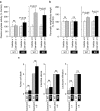Suppression of pancreatitis-related allodynia/hyperalgesia by proteinase-activated receptor-2 in mice
- PMID: 16520745
- PMCID: PMC1617046
- DOI: 10.1038/sj.bjp.0706708
Suppression of pancreatitis-related allodynia/hyperalgesia by proteinase-activated receptor-2 in mice
Abstract
1 Proteinase-activated receptor-2 (PAR2), a receptor activated by trypsin and tryptase, is abundantly expressed in the gastrointestinal tract including the C-fiber terminal, and might play a role in processing of visceral pain. In the present study, we examined and characterized the roles of PAR2 in pancreatitis-related abdominal hyperalgesia/allodynia in mice. 2 Caerulein, administered i.p. once, caused a small increase in abdominal sensitivity to stimulation with von Frey hairs, without causing pancreatitis, in PAR2-knockout (KO) mice, but not wild-type (WT) mice. 3 Caerulein, given hourly six times in total, caused more profound abdominal hyperalgesia/allodynia in PAR2-KO mice, as compared with WT mice, although no significant differences were detected in the severity of pancreatitis between the KO and WT animals. 4 The PAR2-activating peptide, 2-furoyl-LIGRL-NH(2), coadministered repeatedly with caerulein six times in total, abolished the caerulein-evoked abdominal hyperalgesia/allodynia in WT, but not PAR2-KO, mice. Repeated doses of 2-furoyl-LIGRL-NH(2) moderately attenuated the severity of caerulein-induced pancreatitis in WT animals. 5 Our data from experiments using PAR2-KO mice provide evidence that PAR2 functions to attenuate pancreatitis-related abdominal hyperalgesia/allodynia without affecting pancreatitis itself, although the PAR2AP applied exogenously is not only antinociceptive but also anti-inflammatory.
Figures





Similar articles
-
Colonic hyperalgesia triggered by proteinase-activated receptor-2 in mice: involvement of endogenous bradykinin.Neurosci Lett. 2006 Jul 10;402(1-2):167-72. doi: 10.1016/j.neulet.2006.03.074. Epub 2006 Apr 27. Neurosci Lett. 2006. PMID: 16644120
-
The proteinase inhibitor camostat mesilate suppresses pancreatic pain in rodents.Life Sci. 2007 May 1;80(21):1999-2004. doi: 10.1016/j.lfs.2007.02.044. Epub 2007 Mar 12. Life Sci. 2007. PMID: 17433371
-
Proteinase-activated receptor 2 mediates thermal hyperalgesia and is upregulated in a rat model of chronic pancreatitis.Pancreas. 2011 Mar;40(2):300-7. doi: 10.1097/MPA.0b013e318201cbc1. Pancreas. 2011. PMID: 21311307
-
Protease-activated receptor 2 signalling pathways: a role in pain processing.Expert Opin Ther Targets. 2014 Jan;18(1):15-27. doi: 10.1517/14728222.2014.844792. Epub 2013 Oct 23. Expert Opin Ther Targets. 2014. PMID: 24147628 Review.
-
Protease-activated receptors and inflammatory hyperalgesia.Mem Inst Oswaldo Cruz. 2005 Mar;100 Suppl 1:173-6. doi: 10.1590/s0074-02762005000900029. Epub 2005 Jun 14. Mem Inst Oswaldo Cruz. 2005. PMID: 15962118 Review.
Cited by
-
Pathway-selective antagonism of proteinase activated receptor 2.Br J Pharmacol. 2014 Sep;171(17):4112-24. doi: 10.1111/bph.12757. Epub 2014 Jul 2. Br J Pharmacol. 2014. PMID: 24821440 Free PMC article.
-
Animal Models: Challenges and Opportunities to Determine Optimal Experimental Models of Pancreatitis and Pancreatic Cancer.Pancreas. 2019 Jul;48(6):759-779. doi: 10.1097/MPA.0000000000001335. Pancreas. 2019. PMID: 31206467 Free PMC article. Review.
-
Nitric Oxide Stimulates Acute Pancreatitis Pain via Activating the NF-κB Signaling Pathway and Inhibiting the Kappa Opioid Receptor.Oxid Med Cell Longev. 2020 May 7;2020:9230958. doi: 10.1155/2020/9230958. eCollection 2020. Oxid Med Cell Longev. 2020. PMID: 32454946 Free PMC article.
-
Development of highly potent protease-activated receptor 2 agonists via synthetic lipid tethering.FASEB J. 2013 Apr;27(4):1498-510. doi: 10.1096/fj.12-217323. Epub 2013 Jan 4. FASEB J. 2013. PMID: 23292071 Free PMC article.
-
Gastrointestinal roles for proteinase-activated receptors in health and disease.Br J Pharmacol. 2008 Mar;153 Suppl 1(Suppl 1):S230-40. doi: 10.1038/sj.bjp.0707491. Epub 2007 Nov 12. Br J Pharmacol. 2008. PMID: 17994114 Free PMC article. Review.
References
-
- AMADESI S., NIE J., VERGNOLLE N., COTTRELL G.S., GRADY E.F., TREVISANI M., MANNI C., GEPPETTI P., MCROBERTS J.A., ENNES H., DAVIS J.B., MAYER E.A., BUNNETT N.W. Protease-activated receptor 2 sensitizes the capsaicin receptor transient receptor potential vanilloid receptor 1 to induce hyperalgesia. J. Neurosci. 2004;24:4300–4312. - PMC - PubMed
-
- CENAC N., COELHO A.M., NGUYEN C., COMPTON S., ANDRADE-GORDON P., MACNAUGHTON W.K., WALLACE J.L., HOLLENBERG M.D., BUNNETT N.W., GARCIA-VILLAR R., BUENO L., VERGNOLLE N. Induction of intestinal inflammation in mouse by activation of proteinase-activated receptor-2. Am. J. Pathol. 2002;161:1903–1915. - PMC - PubMed
-
- COCKS T.M., SOZZI V., MOFFATT J.D., SELEMIDIS S. Protease-activated receptors mediate apamin-sensitive relaxation of mouse and guinea pig gastrointestinal smooth muscle. Gastroenterology. 1999;116:586–592. - PubMed
-
- COELHO A.M., VERGNOLLE N., GUIARD B., FIORAMONTI J., BUENO L. Proteinases and proteinase-activated receptor 2: a possible role to promote visceral hyperalgesia in rats. Gastroenterology. 2002;122:1035–1047. - PubMed
-
- COLOGNATO R., SLUPSKY J.R., JENDRACH M., BURYSEK L., SYROVETS T., SIMMET T. Differential expression and regulation of protease-activated receptors in human peripheral monocytes and monocyte-derived antigen-presenting cells. Blood. 2003;102:2645–2652. - PubMed
Publication types
MeSH terms
Substances
LinkOut - more resources
Full Text Sources
Other Literature Sources
Medical
Molecular Biology Databases
Research Materials

